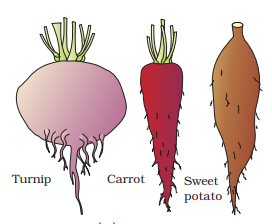Batrachospermum Occurrence:- (1) Batrachospermum is fresh water alga. (2) It is found in clear, cool, and running streams. (3) Deepwater plants are dark violet or reddish in color. But the shallow-water species are olive green. (4) The intensity of light changes the color of pigments. (5) The thallus is attached to the substratum. Vegetative structure (1) The thallus of an adult plant is soft, thick, filamentous. (2) It is freely branched and gelatinous. (3) The central axis is made up of a single row of large cells. Whorls of branches of limited growth are developed on this axis. (4) These branches are filamentous and dichotomously arranged. (5) The main axis is corticated. It consists of a row of elongated cylindrical cells....
Morphology of Flowering plant
Root :-
 |
| A -Tap root B - adventatious Root |
Mainly in exogen plants ,the direct elongation of the bodily
structure results in the formation of primary root that grows within the soil
.
It bears lateral roots of many orders that square measure remarked as
secondary, tertiary, etc. roots.
the first roots and its branches represent the
faucet scheme, as seen within the mustard plant. In monocotyledonous plants,
the first root is brief lived and is replaced by an outsized range of roots.
These roots originate from the bottom of the stem and represent the fibrous
scheme, as seen within the wheat plant .
Types of root :-
A –Tap root
B- adventatious root
Root :-
In some plants, like grass, Monstera and therefore the
Indian banyan, roots arise from elements of the plant apart from the bodily
structure and square measure known as accidental roots .
The main functions of
the foundation system square measure absorption of water and minerals from the
soil, providing a correct anchorage to the plant elements, storing reserve food
material and synthesis of plant growth regulators.
Regions of the foundation :-
 |
| Regions of a typical root |
The root is roofed at the apex by a thimble-like structure
known as the foundation cap .
It protects the tender apex of the
foundation because it makes its means through the soil. some millimetres higher
than the foundation cap is that the region of meristematic activity.
The cells
of this region square measure terribly little, thin-walled and with dense
living substance.
They divide repeatedly.
The cells proximal to the current
region endure fast elongation and enlargement and square measure to blame for
the expansion of the foundation long. This region is termed the region of
elongation.
The cells of the elongation zone step by step differentiate
and mature. Hence, this zone, proximal to region of elongation, is termed the
region of maturation.
From this region a number of the cuticular cells type
terribly fine and delicate, thread-like structures known as root hairs.
These
root hairs absorb water and minerals from the soil.
Modification of Root :-
Roots in some plants amendment their form and structure and
become changed to perform functions apart from absorption and conductivity of
water and minerals.
they're changed for support storage of food and respiration
.
 |
| Storage Root |
Tap roots of carrot, turnips and accidental roots of sweet potato, get swollen
and store food.
Hanging a part of the
Indian banyan ,These square measure known as prop roots.
Similarly, the stems
of maize and sugarcane have supporting roots kicking off of the lower nodes of
the stem.
 |
| Pneumatophore |
These square measure known as stilt roots. In some plants like genus
Rhizophora growing in mucky areas, several roots start of the bottom and grow
vertically upwards.
Such roots, known as pneumatophores, facilitate to urge
element for respiration
I wish for the great of success in all of our destiny endeavors
ReplyDeleteThey lead a smooth workflow see this website thanks to their transparent communication and mindfulness.
ReplyDeleteThat is the excellent mindset, nonetheless is just not help to make every sence whatsoever preaching about that mather. Virtually any method many thanks in addition to i had endeavor to promote your own article in to delicius nevertheless it is apparently a dilemma using your information sites can you please recheck the idea. thanks once more. anti parasite herbsanti parasitic foods
ReplyDelete